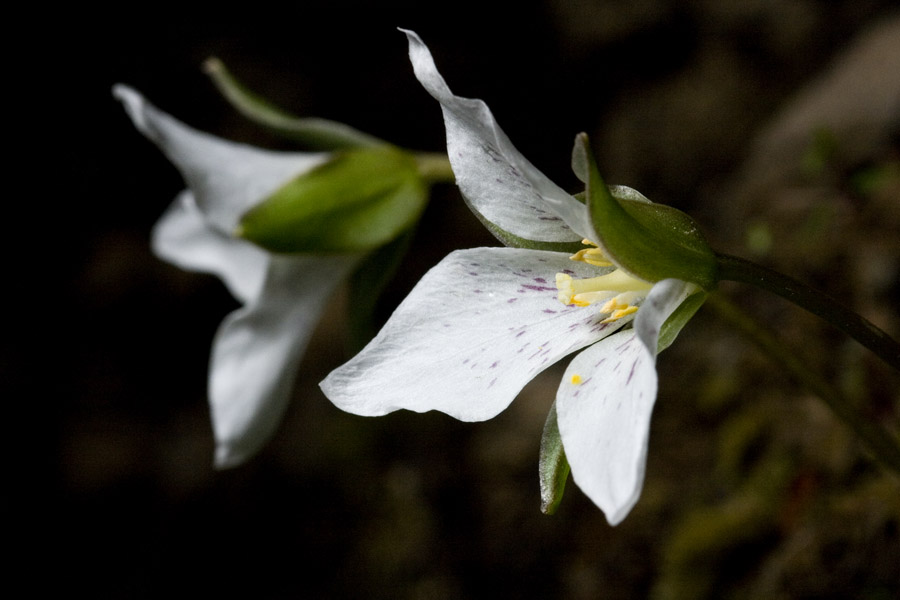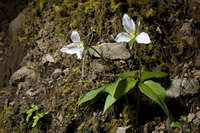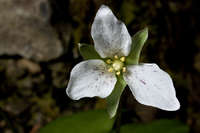|
|
|
|
Family: Melanthiaceae
brook wakerobin
[Trillium rivale S.Watson] |
Rhizomes horizontal, short, praemorse, fleshy. Scapes 1-2, round in cross section, 0.4-1.5 dm, slender, glabrous. Bracts distinctly petiolate; blade bluish green, occasionally with silvery green pattern along major veins, ovate-lanceolate, 1.5-8 × 0.8-6 cm, somewhat thick-textured, glossy, weakly to strongly cordate basally, apex long-acuminate; petiole (0.5-)1-3(-6) cm. Flower erect, rapidly recurving below bracts after pollination, ± odorless; sepals conspicuous, spreading, green, weakly sulcate, oblong or tapered apically, usually shorter and narrower than petals, 10-23 × 4-8 mm, margins entire, apex rounded-apiculate; petals erect-spreading, not recurved or only in distal 1/2, white (rarely pale pink), usually with dark madder-purple flecks, rarely almost entirely covered with madder-purple, color not changing with age, veins inconspicuous, not engraved, ovate-cordate to ± orbicular, tapered bluntly apically above middle, 1.3-2.8 × 1-2.4 cm, ± thin-textured, base rounded, cuneate, margins entire, mostly without undulations, apex ± apiculate-acuminate; stamens erect, 5-12 mm; filaments white, ± equaling anthers; anthers straight, yellow, 3-6 mm, dehiscence ± extrorse; connectives not extended beyond anther sacs; ovary creamy white, ovoid, weakly 6-angled but angles in close pairs, giving superficial impression of 3-angled ovary, short, 3-9 × 4 mm, somewhat obscured by anthers broadly attached; stigmas recurved and appearing ± lobed adaxially, at least in dried specimens, connate basally to distinct and closely grouped, white or cream, 2-4 mm, uniformly thick, fleshy; pedicel strongly erect at anthesis, strongly recurving and elongating below bracts after pollination, 2.5-11 cm. Fruits greenish white, odorless, globose, 0.9-1.2 × 0.8-1 cm, pulpy, not juicy. 2n = 10. Flowering spring (early Mar--early Jun); withering in summer. Open, grassy hillsides, manzanita shrubbery, pine groves, clearings in sequoia groves, roadside banks, ledges, gravelly talus; 10--1400 m; Calif., Oreg. Trillium rivale is confined to the Klamath and Siskiyou mountains of southwestern Oregon and California. It has a strong affinity for banks along streams and adjacent to trickles in Darlingtonia bogs, mainly on serpentine soils. After flowering, the entire plant may enlarge and become more robust and turgid with very glossy leaves.
|




